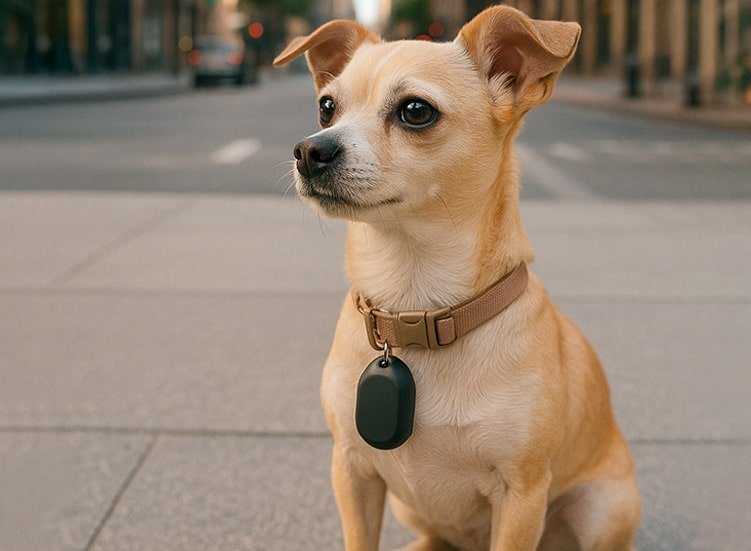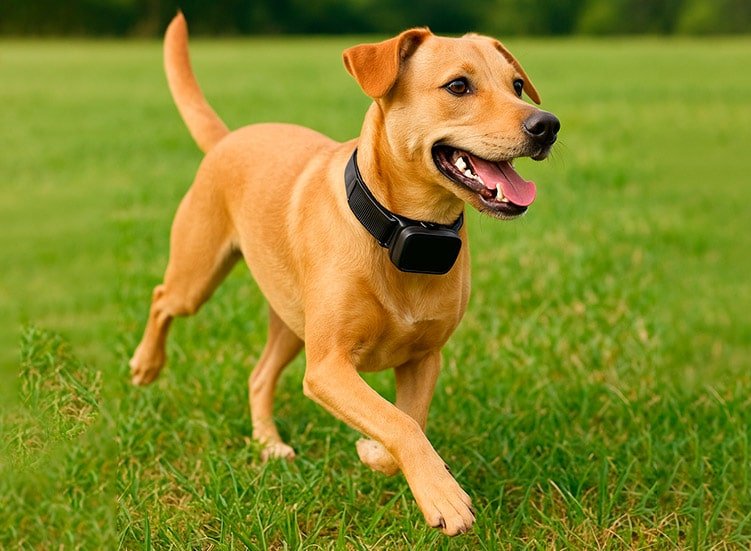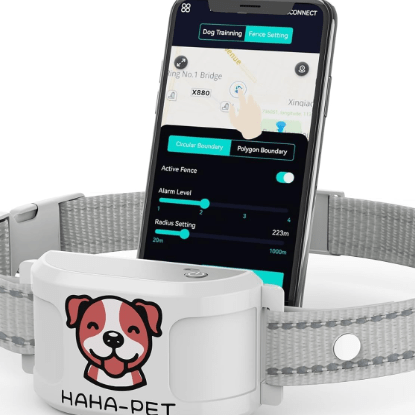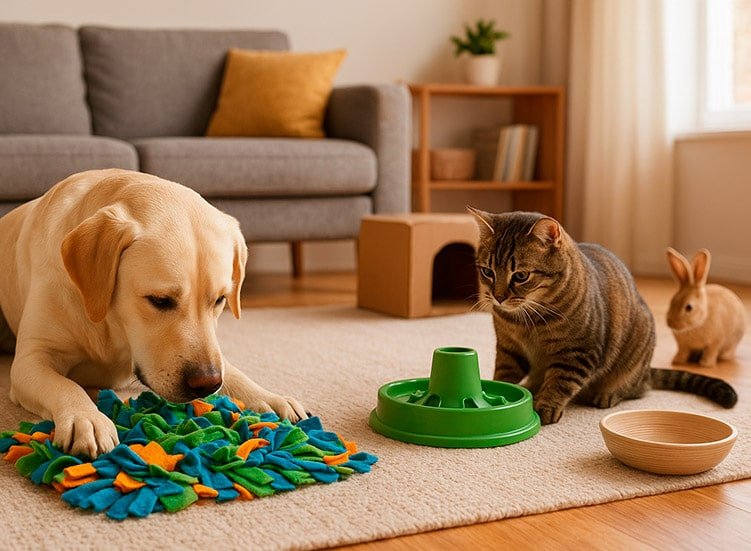A GPS dog tracker is one of the most efficient tools to ensure your pet’s safety.
After all, losing a dog is every owner’s nightmare—whether it’s an open gate, an unleashed walk, or sudden fireworks that cause panic.
In just a few seconds, your pet can disappear. According to animal protection organizations, thousands of dogs get lost every year, and sadly, many are never found.
That’s why more than just an accessory, it’s truly a tool for safety and peace of mind.
In this complete guide, you’ll learn:
- What a GPS dog tracker is.
- The types of devices and technologies available.
- How to choose the best model for your pet.
- A comparison of the main devices on the market.
- Tips to get the most out of your investment.
What is a GPS Dog Tracker?
A GPS dog tracker is a compact device, usually attached to the collar, that uses location technology to show in real time where your pet is.
Unlike a microchip, which only contains identification data readable at clinics and shelters, a tracker allows active monitoring through a smartphone app.
How does it work?
Most models use GPS to determine location, combined with mobile networks (4G/5G) or Wi-Fi to transmit your pet’s position to your phone. Some simpler models use Bluetooth, with limited range, recommended only for indoor use.
Benefits of a GPS Dog Tracker
- Safety: quickly locate your pet in case of escape.
- Peace of mind: monitor walks and movements, even when your dog is with someone else.
- Health tracking: some models record steps and calories burned, helping with weight control.
- Travel use: perfect for pet-friendly hotels, hiking, or camping trips.
- Virtual fence (geofencing): get alerts when your dog leaves a defined safe area.
Types of GPS Dog Trackers
When it comes to pet trackers, it’s important to understand that they can vary both in tracking technology and in physical design.
By technology:
-
With SIM card and subscription plan
These are the most accurate and work anywhere with cellular coverage. They usually require a monthly or yearly subscription. -
No SIM (Bluetooth or Wi-Fi)
These have limited range (typically 100–300 feet). They are cheaper and best for indoor or restricted areas. -
Smart collars
The GPS is built into the collar itself, avoiding loose parts. They usually feature robust, waterproof, and impact-resistant designs. -
Multifunctional
Besides tracking, they may include extras like health monitoring, vibration training, and even LED lights for night visibility.
By physical format:
Not all trackers are large or heavy—today, there are compact options even for small dogs. The main formats are:
GPS Collar with built-in tracker
More common for medium and large dogs. The tracker is already integrated, with no need for extra accessories.
- Pros: convenient, nothing extra to attach.
- Cons: less discreet, may be too heavy for very small dogs.
Clip-on GPS module (a device attached to the collar your dog already wears)
- Sizes vary: some models are as small as 1–1.5 inches and weigh under 1 oz.
- Examples: Tractive Mini and Petfon, both compact and lightweight.
Ultra-small trackers (look like keychains or pendants)
- Ideal for small dogs and cats.
- Usually have shorter battery life, but are very comfortable for pets.
- Some combine Bluetooth + GPS, such as the Jiobit Smart Tag, offering discreet hybrid tracking.
Quick comparison table:
| Model | Best for | Key highlights |
|---|---|---|
| Tractive GPS | Small to medium dogs, global tracking | Real-time, geofencing, health tracking, LTE-M coverage, lightweight and durable |
| Jiobit Smart Tag | Small and discreet use | Lightweight, multi-network (BT/Wi-Fi/cellular), geofencing |
| Weenect Dog GPS | Small dogs, cost-effective | LED light, vibration, activity tracking, compact design |
| FitBark GPS (2nd Gen) | Very small pets | Detailed health insights, long battery life, ultra lightweight |
| Whistle GO Explore | Small to medium pets with health + tracking focus | Tracking + health metrics, up to ~20-day battery life |
How to Choose the Best GPS Dog Tracker
- Signal accuracy: GPS + cellular networks usually provide the best performance.
- Battery life: models lasting 2 to 7 days are more practical for daily use.
- Size and weight: important so the device doesn’t bother your pet.
- Water resistance: essential for dogs that swim or play in the rain.
- User-friendly app: easy-to-use interface with customizable alerts.
- Total cost: consider both the device price + monthly subscription fee.
Comparison of the Best GPS Dog Trackers
| Model | Battery Life | Connection Type | Extra Features | Average Price* |
|---|---|---|---|---|
| Tractive GPS Dog 4 | Up to 5 days | GPS + 4G LTE | Geofencing, location history | Monthly subscription required |
| Weenect Dogs 2 | Up to 3 days | GPS + 4G LTE | Voice calls, location history | Monthly subscription required |
| PitPat Dog GPS Tracker | Several weeks | GPS (no mobile plans) | No subscription, wireless charging, ultra-light | One-time payment |
| Invoxia Pet Tracker | Up to 7 days | GPS + 4G LTE | Activity monitoring | Monthly subscription required |
*Price information is approximate and may vary depending on the store, subscription plan, or promotions.
How to Set Up and Use a GPS Dog Tracker
- Fully charge the device.
- Download and install the official app.
- Insert a SIM card if required (some models include built-in eSIM).
- Attach the tracker securely to your dog’s collar.
- Set up safe zones (geofences) in the app.
- Test range and accuracy before real outdoor use.
Tips for Getting the Best Performance from Your GPS Dog Tracker

- Keep the firmware and app updated.
- Charge regularly—don’t wait until the battery runs out completely.
- Test the tracker on walks to check accuracy.
- Always use with a comfortable and secure collar.
Possible Downsides of GPS Dog Trackers
- Limited battery life: choose models with fast-charging capability.
- Network coverage: in rural areas, accuracy may decrease.
- Subscriptions: include the monthly fee in your budget before buying.
Where to Buy
You can find GPS dog trackers at:
- Amazon.com
- Pet shops (both physical and online).
- Specialized pet tech stores.
❓ (FAQ) Frequently Asked Questions about GPS Dog Trackers
No. A microchip is a passive identifier, while a GPS tracker allows real-time location tracking.
Most models with nationwide coverage require a subscription.
Yes, as long as the size and weight are appropriate.
Real-time tracking requires a connection, but some models can store location history and upload it later.
Yes, as long as the model is compatible with the local mobile network (2G, 4G, LTE-M, etc.). Always check the manufacturer’s list of supported countries before purchase.
Yes, but it’s important to check the weight and size of the device to avoid discomfort. Some models are designed specifically for smaller animals.
Most do, since they use cellular networks to send real-time location updates to the app. Some offline models exist, but with limited features.
Subscription-based trackers offer unlimited real-time tracking and more features, while non-subscription models usually have limited range and rely on local connections like Bluetooth or Wi-Fi.
Conclusion on GPS Dog Trackers
Investing in a GPS dog tracker means investing in your pet’s safety and your peace of mind.
With so many options available, it’s worth analyzing features, battery life, and value for money to choose the ideal model.
Whether to prevent escapes or simply monitor walks, this small device can make a big difference.
Click here for more content about the pet world.






